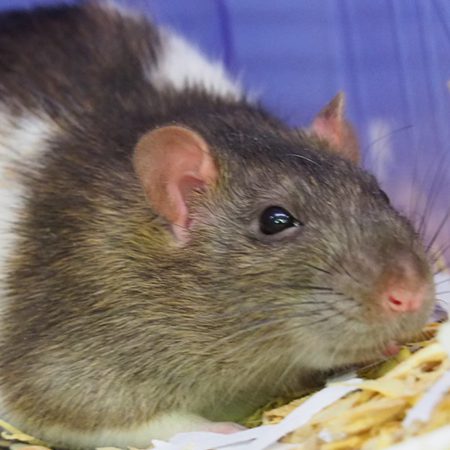Rat (Domesticated)
Rattus norvegicus domestica
The common domesticated rat is also sometimes referred to at the fancy rat, it is a domesticated form of the brown rat. The fancy rat is one of the most common species of rat kept as a pet, which has been gaining large popularity in the United States. The name fancy rat derives from the idea of animal fancy (the promotion of domesticated animals). Originally these rats were target of blood sport (animal fighting) in the 18th - 19th century. Later, and thankfully they were bred as pets, they now can be found in a wide variety of coat colors and patterns.
You can find the common domesticated rat sold in pet stores and breeders. Fancy rats are generally good self groomers, and are affordable compared to other small pets (this one of their biggest draws). In addition, they are quite independent, loyal, and can be easily trained. They are considered to be particularly intelligent rodents. In addition to being popular pets, they have found use in medical research. Domesticated rats are physiologically very similar to humans. When used in the medical field, they are referred to as laboratory rats.
Domesticated rats differ from their wild counterparts in many ways, but they are not removed enough to justify a distinct subspecies. The most distinct differences are apparent in the coloring. While more random color mutations may occur in the wild, they are typically a dark brown, while fancy rats may be anything from white to cinnamon to blue. Behaviorally, domesticated pet rates are much tamer than wild ones. They are more comfortable around humans and seek out their owners when roaming.

Rats have a rich history in migration, having originated in northern China, they settled in Norway during the 1800s. Today, they’ve been transported to the U.S.
HABITAT -These animals live in human controlled environments, kept as pets in homes.
DIET -Rats are omnivorous scavengers, they’ll eat fruits, vegetables, and other protein.
FUN FACT -Rats have excellent memories and can memorize navigation paths very quickly!
SOCIAL BEHAVIOR -Rats are social creatures, they do best kept with other rats.
ACTIVITY -Rats are nocturnal, they are most active in the evening and sleep during the day.
PREDATORS -Predators include cats, birds of prey, snakes, and weasels.
SIZE -The average body length is 9 - 11 inches, plus a tail of 7 - 9 inches, weighing as much as 2 pounds.
RELATIVES -The most common relative of the fancy rats is the wild brown rat.
CONSERVATION -Being domesticated, they are not currently endangered. They are not evaluated on IUCN red list.
Cub Creek Animal Care Information
Housing - Our rats live in the small animal room of the animal area, they have their own special small animal critter enclosures. The enclosure provides plenty of space allowing for a variety of hide spaces to make them feel safe and room to explore. Their enclosure is bedded with shavings to make cleanup easy and they always have access to clean water.
Diet - The main staple of our rats diet is rodent blocks, this food ensures they get all the nutrition they need. To supplement this diet, they get all sorts of special delicious fruit and vegetable treats.
Enrichment - Our rats are very social animals, they enjoy playing with one another and interacting with our campers. During the summertime, campers will make them special toys from cardboard and other materials. We really try to make sure these smart animals are mentally stimulated with special toys. Sometimes they are food motivated toys where they have to solve a puzzle or maze to get the treat!

